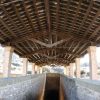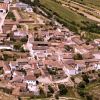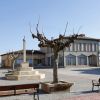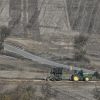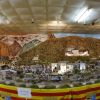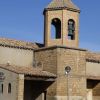The height of the village, 493 metres above sea level, makes Lagunarotta a magnificent viewpoint looking out over the pre-Pyrenean mountains and the plains of Los Monegros. From here it is possible to make out neighbouring regions that border Somontano, those of Ribagorza, La Litera, Cinca Medio, Monegros, Hoya de Huesca and even Catalunya. To the north eyes are drawn to the mighty Pyrenean peaks before resting on the gentler pre-Pyrenean mountain ranges and finally roaming over the immense plains of the south-east.
In general the relief of the south is tabular; the strata lay horizontally as this area did not suffer tectonic movements of any great significance after the sedimentation of materials. There are many raised tablelands, rocky and dry, that are known locally as sasos; the name is derived from the Roman word saxum meaning stone. Many of these plateaus are covered in boulders making agriculture difficult: their removal every year is added work and their presence wears down many crops.
Fields of almond trees, olive trees and cereal, bordered by kermes oak and holm oak, offer a chance to take in birdlife that includes the Griffon Vulture, Northern Goshawk and partridges. The majority of the area is covered by crops and as a consequence there are great seasonal differences in the landscape. Spring offers a green pasture dotted with white splashes of almond blossom. After the cereal harvest, small patches of forest are visible, hot and dry in summer, but offering much needed shade and the unmistakable smell of resin and aromatic plants. It is not uncommon to come across groups of partridge in the surrounding area.
The octagonal layout of the streets of Lagunarotta affords it an ordered aspect that is very different to other villages in Somontano. The streets form compact blocks made up of small houses of a similar height, constructed from brick, tile, packed earth and masonry. Calle Mayor and Calle Yedra (streets) converge in a space that is relatively wide and open, known locally as the placeta, meaning small square. To the north-west of the village two other streets (Iglesia and del Horno) form a square that is home to the church of San Gil Abad and that also boasts magnificent views.
The origins of the parish church are Romanesque and it dates back to the 12th century as can be seen on the outside of the semicircular apse. It was drastically renovated in the 16th century to include the semi-circular doorway and the two lower sections of the tower. The ruinous state of the church motivated the most recent renovations, which took place between 1964 and 1966.



